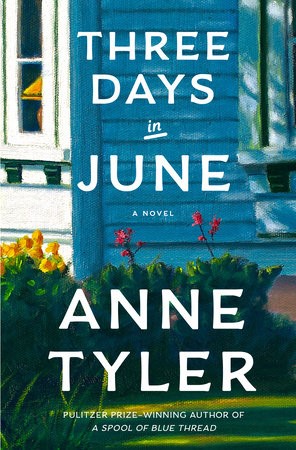“Three Days in June” by Anne Tyler
Reviewed by STEVEN G. KELLMAN
At the beginning of Three Days in June, Anne Tyler’s 24th novel, Gail Baines is told that, after eleven years as assistant headmistress at a private girls’ school in Baltimore, she will be replaced. The reason given is that she “lacks people skills.” The rest of the novel, which Gail herself narrates, provides sufficient evidence for that assessment.
However, for the next three hectic days, 61-year-old Gail is focused less on her employment prospects than her daughter Debbie’s wedding. The three sections of Tyler’s effervescent novel recount the day before, the day of, and the day after the ceremony in which Debbie marries a fellow lawyer named Kenneth. Gail takes us through the rehearsal, the exchange of vows, the reception, and the morning after.
The father of the bride, Max Baines, who lives in Delaware, arrives for the joyous occasion. Because their divorce was relatively amicable, Gail, his ex, lets him stay in her spare room. She is not pleased that Max, without consulting her, has brought along a cat. “Boundaries, that was his problem,” she explains. “I myself was all about boundaries.”

But boundaries were breached, according to their daughter. As Debbie, weeping, tells her parents, she has just been told that her fiancé recently, deceitfully slept with another woman. Can she possibly marry this unfaithful mate? Nevertheless, proclaiming his innocence, Kenneth insists that Debbie was misinformed, that he did not in fact cheat on her. And she decides to proceed with the wedding. Gail is convinced that her prospective son-in-law Kenneth is a liar, but since Gail is our only source of information, we never know for certain. And we never know whether Debbie actually believes Kenneth or decides to marry him despite his transgression. Standing by her man, she states: “I refuse to be one of those wives who hold a grudge forever.”
Debbie notes the irony in her mother’s skepticism over Kenneth’s alibi, considering what she believes about the divorce that sundered Gail and Max. However, it becomes clear that Debbie does not begin to understand the circumstances of her parents’ split. A reader also begins to suspect that all the fuss over Debbie’s wedding is really a Hitchcockian MacGuffin – a narrative sleight by Tyler to distract us from a subject Gail would just as soon ignore: her own marriage and divorce.
“I’ve never been the type to play back scenes from my past,” Gail admits. However, gradually, during the course of this deft short novel, she plays back more and more of those scenes. Despite the novel’s tight concentration on three days in June, its attention is elsewhere, on the shelf life of adoration. What does it mean when your husband ceases telling you that you are perfect, that you “hung the moon”? A question posed by an old flame at the wedding reception resonates throughout the book’s remaining pages and beyond: “And are you happy in the life you’ve chosen, Gail?”
It would be churlish to reveal much more, except to note Tyler’s characteristic skill at formulating dialogue and shaping plot. This is a novel about middle-class folk who represent what some call “white privilege,” and readers looking for impassioned exposés of social injustice need to keep looking. Instead, Three Days in June offers the pleasures of understated literary craft.
At both the beginning and the end of the novel, Gail observes that: “People don’t tap their watches anymore.” Confining her story to three days that force its narrator to review the span of her years, Tyler taps into fundamental questions of how best to spend the hours of our lives.
——————————————————–
“Three Days in June” by Anne Tyler, Knopf, $27
